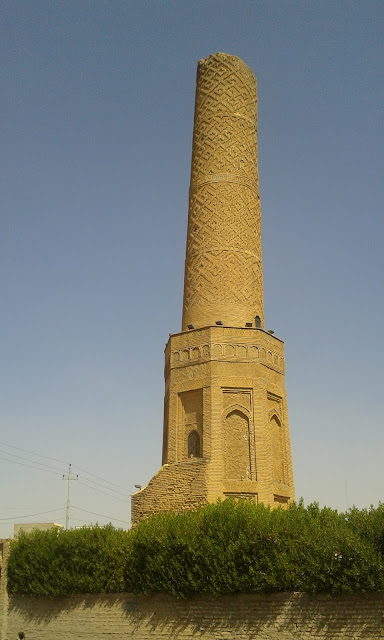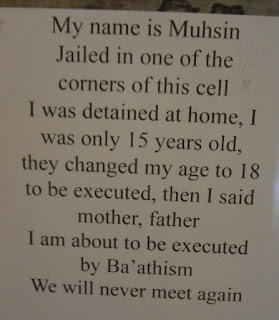Wednesday, October 14, 2015
Monday, October 12, 2015
Tea time
 Right below the citadel is this lovely chixana (tea house). I like to think that in some form or another people have been sitting here for 9000 years drinking tea and talking rubbish.
Right below the citadel is this lovely chixana (tea house). I like to think that in some form or another people have been sitting here for 9000 years drinking tea and talking rubbish.Women sit inside and men sit out in the street. While no one would object or cause a fuss if women sat outside, they would not be considered 'respectable'.
Friday, October 9, 2015
Klash
Kurdistan has never been wealthy so most crafts are limited to practical everyday objects rather than any type of 'high art'. Even these crafts are today rather marginal as most production ground to halt after the destruction of Kurdish villages during the Anfal campaigns and few have been revived.
One craft that still remains very popular is the traditional Kurdish shoes or klash. Still handmade in the Hawrami region in the southeast of Iraqi Kurdish, klash are made entirely from scratch. The base of the shoe consists of thin strips of rubber tightly drawn together from which the sole is then cut and covered in cloth. This is held together by a piece of leather which is then cut when first worn. The pieces that hold the leather are supposed to be made from dried bull penis, and although everyone tells me the same story, I am not convinced. The uppers are all hand stitched from string much like macrame but much finer. There is no left and right and they don't do well in wet weather.
These men in the bazaar are repairing klash, whitening the uppers and recovering the soles.
Of course next to the klash repairs are men selling traditional clothing.

One craft that still remains very popular is the traditional Kurdish shoes or klash. Still handmade in the Hawrami region in the southeast of Iraqi Kurdish, klash are made entirely from scratch. The base of the shoe consists of thin strips of rubber tightly drawn together from which the sole is then cut and covered in cloth. This is held together by a piece of leather which is then cut when first worn. The pieces that hold the leather are supposed to be made from dried bull penis, and although everyone tells me the same story, I am not convinced. The uppers are all hand stitched from string much like macrame but much finer. There is no left and right and they don't do well in wet weather.
These men in the bazaar are repairing klash, whitening the uppers and recovering the soles.
Of course next to the klash repairs are men selling traditional clothing.

Thursday, October 8, 2015
A Guide to the politics of the Middle East
I read this and thought it too good not to share.
The Middle East
No doubt you will find this invaluable.
A number of people are confused by what is going on in the Middle East.
Let me explain.
We support the Iraqi government in the fight against ISIS.
We don't like ISIS, but ISIS is supported by Saudi Arabia who we do like.
We don't like Assad in Syria and we support the fight against him, but ISIS is also fighting against him.
We don't like Iran, but Iran supports the Iraqi government in its fight against ISIS.
So some of our friends support our enemies.
Some enemies are now our friends and some of our enemies are fighting against our other enemies, who we want to lose.
We don't, however want our enemies who are fighting our enemies to win.
If the people we want to defeat are defeated, they could be replaced by people we like even less.
And all this was started by us invading a country to drive out terrorists; who were not actually there until we went in to drive them out.
Mustafa's story
Mustafa works at the Mihrako hotel and with so few international visitors was always keen to practice his English, at the same time insisting on making me truly awful coffee. In the course of one of these conversations I asked where he was from and he explained that he had a Kurdish father and an Arab mother and was born and raised in Mosul. Mustafa is intensely proud of being a 'Mosulman', describing Mosul as the most beautiful city in Iraq, if not the world.
When ISIS stormed Mosul Mustafa's world came crashing down. His parents fled with his younger brothers and sisters but Mustafa stayed, keen to continue his economics degree as he was only 21.
Not long after the invasion he was walking home one evening with his close friend Omer when they were stopped by a ISIS gunman carrying a heavy pistol, who insisted on seeing their identity papers. Mustafa's papers had him listed as a Kurd and Omer's papers showed that he had been in the Iraq army. The gunman declared that he was going to kill them both - Mustafa for having a Kurdish father and Omer for having been in the army. Immediately he shot Omer in the head three times. Miraculously the gun then jammed giving Mustafa the chance to ran and jump over a wall into the grounds of a school and escape. From there he made his way back to Omer's brothers house and later they both returned in a car to collect Omer's body.(he showed me the photos!)
Despite this Mustafa was still reluctant to leave Mosul until a few weeks later an ISIS official at the university insisted he work for ISIS as he had a good knowledge of several languages. That night he left the city on foot and make his way to the Kurdish lines and on to Slemani where his parents were living.
This story is told in an even tone unpinned with emotional pain, but he is not looking for sympathy or pity, this is just his story among many like it.
Since then he has had an offer of help from a cousin in Britain but he refuses to leave Iraq, convinced that the ISIS regime cannot last and he will be able to return to his home in 'beautiful' Mosul . That, however is a story I have heard from several Syrians and after five years of war, their time of waiting to return has come to an end.
When ISIS stormed Mosul Mustafa's world came crashing down. His parents fled with his younger brothers and sisters but Mustafa stayed, keen to continue his economics degree as he was only 21.
Not long after the invasion he was walking home one evening with his close friend Omer when they were stopped by a ISIS gunman carrying a heavy pistol, who insisted on seeing their identity papers. Mustafa's papers had him listed as a Kurd and Omer's papers showed that he had been in the Iraq army. The gunman declared that he was going to kill them both - Mustafa for having a Kurdish father and Omer for having been in the army. Immediately he shot Omer in the head three times. Miraculously the gun then jammed giving Mustafa the chance to ran and jump over a wall into the grounds of a school and escape. From there he made his way back to Omer's brothers house and later they both returned in a car to collect Omer's body.(he showed me the photos!)
Despite this Mustafa was still reluctant to leave Mosul until a few weeks later an ISIS official at the university insisted he work for ISIS as he had a good knowledge of several languages. That night he left the city on foot and make his way to the Kurdish lines and on to Slemani where his parents were living.
This story is told in an even tone unpinned with emotional pain, but he is not looking for sympathy or pity, this is just his story among many like it.
Since then he has had an offer of help from a cousin in Britain but he refuses to leave Iraq, convinced that the ISIS regime cannot last and he will be able to return to his home in 'beautiful' Mosul . That, however is a story I have heard from several Syrians and after five years of war, their time of waiting to return has come to an end.
Wednesday, October 7, 2015
Amna Sakura
 In the heart of Slemani is Amna Sakura (Red Security), a purpose built 'security centre' constructed in the early 1980s by Saddam Hussein. One of four detention centres in the city, Amna Sakura was by far the most notorious. Thousands of Kurds were imprisoned here in terrible conditions and many were tortured and executed. One of the 'specialties' of death in
In the heart of Slemani is Amna Sakura (Red Security), a purpose built 'security centre' constructed in the early 1980s by Saddam Hussein. One of four detention centres in the city, Amna Sakura was by far the most notorious. Thousands of Kurds were imprisoned here in terrible conditions and many were tortured and executed. One of the 'specialties' of death in Amna Sakura was that the bodies of the dead were dumped in an outer courtyard to be eaten by stray dogs - later the remains were buried in mass graves in a nearby park. Liberated by the Pershmerga in 1992, Amna Sakura has been pretty much left as it was with a one building being turned into a museum.
It is not an easy place to visit and many Kurds would still like to see it pulled down. Particularly heart breaking are the little notices scratched on the walls.

Tuesday, October 6, 2015
ANFAL
"Was it possible to leave those goats (Kurds) in peace? Looking after them? Serving them? No! Never! The best way was to bury them by bulldozers" Ali Hussan Al-Majeed, Commander in Saddam Hussein's army
 The Anfal attacks on the Kurds were a series of eight campaigns (3 major, 5 minor) to destroy the heartland of Kurdish cultural during the 1980s. Systematic and brutal, the campaigns destroyed 4500 villages and left over 180,000 dead. Mass graves from the Anfal campaigns are still being discovered and the bodies of 10,000 children under five have never been found.
The Anfal attacks on the Kurds were a series of eight campaigns (3 major, 5 minor) to destroy the heartland of Kurdish cultural during the 1980s. Systematic and brutal, the campaigns destroyed 4500 villages and left over 180,000 dead. Mass graves from the Anfal campaigns are still being discovered and the bodies of 10,000 children under five have never been found.
This monument to the victims is Slemani is part of the Amra Sakura museum and is especially moving. One hall is lists the names of the known dead and the other displays photos of just a small proportion of those who died. Part of this memorial is a long corridor. One the ceiling are lights, each light representing a destroyed village. The walls are densely lined with a mosaic of broken pieces of mirror glass, at total of 182,000 pieces, one for each of those who died.
Thursday, October 1, 2015
Subscribe to:
Comments (Atom)







































